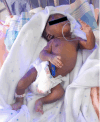Congenital scoliosis with truncus arteriosus type 1 in a preterm neonate: A case report
- PMID: 40881095
- PMCID: PMC12304985
- DOI: 10.5409/wjcp.v14.i3.106439
Congenital scoliosis with truncus arteriosus type 1 in a preterm neonate: A case report
Abstract
Background: Congenital scoliosis (CS) is a spinal deformity caused by defective segmentation and development of vertebrae during early embryogenesis. It occurs in 0.5%-1% in 1000 births and may rarely occur with congenital defects affecting the heart or genitourinary system. Truncus arteriosus (TA) is a life-threatening cardiac defect in which a single arterial trunk supplies both systemic and pulmonary circulation, leading to complications such as pulmonary hypertension, heart failure, and severe hypoxia. Although rare individually, the co-occurrence of both conditions poses unique diagnostic and therapeutic challenges, with limited documentation in medical literature.
Case summary: We present a 36-week preterm neonate with CS associated with TA type 1, presenting with respiratory distress, cyanosis, and altered spinal curvature. This case demonstrates the complexity of managing neonates with multiple congenital defects. Here, the patient was managed with oxygen supplementation, heart failure medication, nasogastric feeding, and multidisciplinary care to optimize her for surgical corrections. A coordinated, interdisciplinary approach was employed to optimize outcomes, particularly in a resource-limited setting. Immediate respiratory and cardiovascular stabilization and long-term orthopedic and cardiac interventions were central to improving the patient's quality of life and survival.
Conclusion: Recognizing co-existing congenital anomalies and their embryological interrelation is critical in holistic patient care, particularly during neonatal and infancy.
Keywords: Case report; Congenital heart disease; Congenital scoliosis; Preterm neonate, Corrective surgery; Truncus arteriosus.
©The Author(s) 2025. Published by Baishideng Publishing Group Inc. All rights reserved.
Conflict of interest statement
Conflict-of-interest statement: The authors declare no conflict of interest.
Figures
References
-
- Bagheri F, Razi A, Birjandinejad A, Amel Farzad S, Peivandi MT, Habibzade Shojaei SRH. Congenital Scoliosis: A Current Concepts Review. J Pediatr Rev. 2021;9:127–136.
-
- Bhansali S, Horenstein MS, Phoon C. Truncus Arteriosus. 2024 Mar 10. In: StatPearls [Internet]. Treasure Island (FL): StatPearls Publishing; 2025 Jan- - PubMed
Publication types
LinkOut - more resources
Full Text Sources



